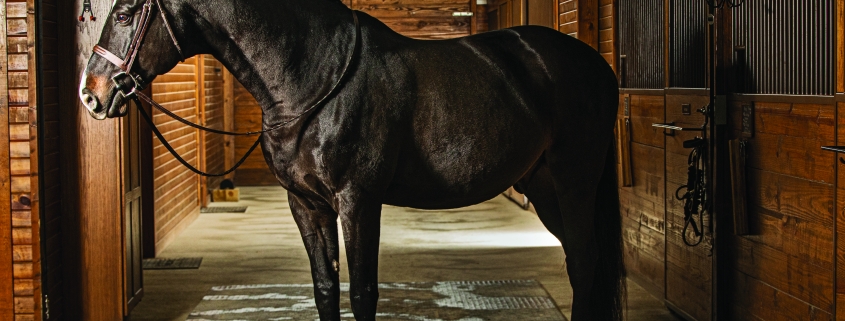BY CHERESE COBB, FREELANCER
Flashy on the outside and a gentleman on the inside, Acado is a 13-year-old Hanoverian. “He’s one of the most handsome horses in the barn,” says Jenny Caldwell, assistant trainer. “When he walks into a different environment, he puts his head up and looks around, but he’s never spooked.” The Show Hunter isn’t just a Steady Eddie; he’s a class act.
History
Hanoverians are one of the oldest warmbloods. They come from destriers: hot-blooded horses who carried fully armored knights into battles, tournaments and jousts. In the 1600s, they were imported into north-central Germany. They worked as cavalry remounts and harness horses.
King George II of England was the first person to breed Hanoverians. In 1735, he founded the Stallion Depot in Celle, Lower Saxony. He used Black Holsteins as a foundation stock. They’re powerful coach horses produced by crossing German mares with Neapolitan, Spanish and Oriental blood.
Modern Hanoverians were used in British royal processions until the reign of Edward VIII when they were replaced by Windsor Greys. At the end of WWII, the breed was mixed with Thoroughbreds and Trakehner. They became increasingly light, agile, athletic and graceful.
Health
Hanoverians may suffer from osteochondritis dissecans (OCD). It’s caused by poor nutrition, physical trauma and rapid growth. OCD creates lesions that encourage fluid buildup, small fractures or cartilage destruction. Twenty-five percent of the time, OCD is found in the fetlocks. Ten percent of Hanoverians get OCD in their hock joints.
With a digestive system that’s similar to rabbits and rats, horses can’t vomit or burp (what goes in must take the long way out). “If a horse gets a belly ache [or colic], its stomach can twist on itself,” Caldwell says. The second leading cause of death in horses, colic is caused by a change of diet, a lack of roughage or parasites. Its symptoms include pawing, restlessness, rapid breathing or violent rolling.
“Acado is treated like an Olympic athlete,” says rider Brooke Brodersen. He has his own masseuse, chiropractor and indoor treadmill. He takes a daily electrolyte, joint supplement and probiotic. Because Acado’s teeth continually grow and are worn down by chewing feed, he gets his teeth floated or filed down twice per year. He also eats high-quality hay and snacks on carrots, apples and, occasionally, licorice jelly beans.
Hunters & Jumpers
Show hunter Acado wears aluminum shoes on his front hooves and steel shoes on his backs. His mane and tail are braided, and his tack is a simple snaffle bit and traditional bridle. Brodersen wears a black helmet, black gloves, tan breeches, black field boots, a white show shirt and a dark-colored hunt coat.
In the ring, Hunters like Acado jump over eight to 12 fences that are conservative and natural, including colors like white, brown and green. “The judges are really looking for a perfect flow without bobbles,” Brodersen says. They’re looking for horses that are well-mannered, athletic and attractive to ride safely and smoothly over the obstacles.
“It looks kind of like we’re going around the ring automatically, but every single step requires communication between the horse and rider,” Brodersen says. “If you’re not paying attention, steps can get stretched out, and you can’t make the distance of the jump.”
Jumpers ride over technically difficult courses that twist and turn. Fences are bright, colorful and lofty. Jumpers’ manes and tails aren’t braided. Saddle pads and ear bonnets are allowed. If horses knock down a fence, stop at a fence or don’t complete the course in a certain time limit, they incur “faults” or penalties. The horse with the fewest faults and the fastest time wins.


